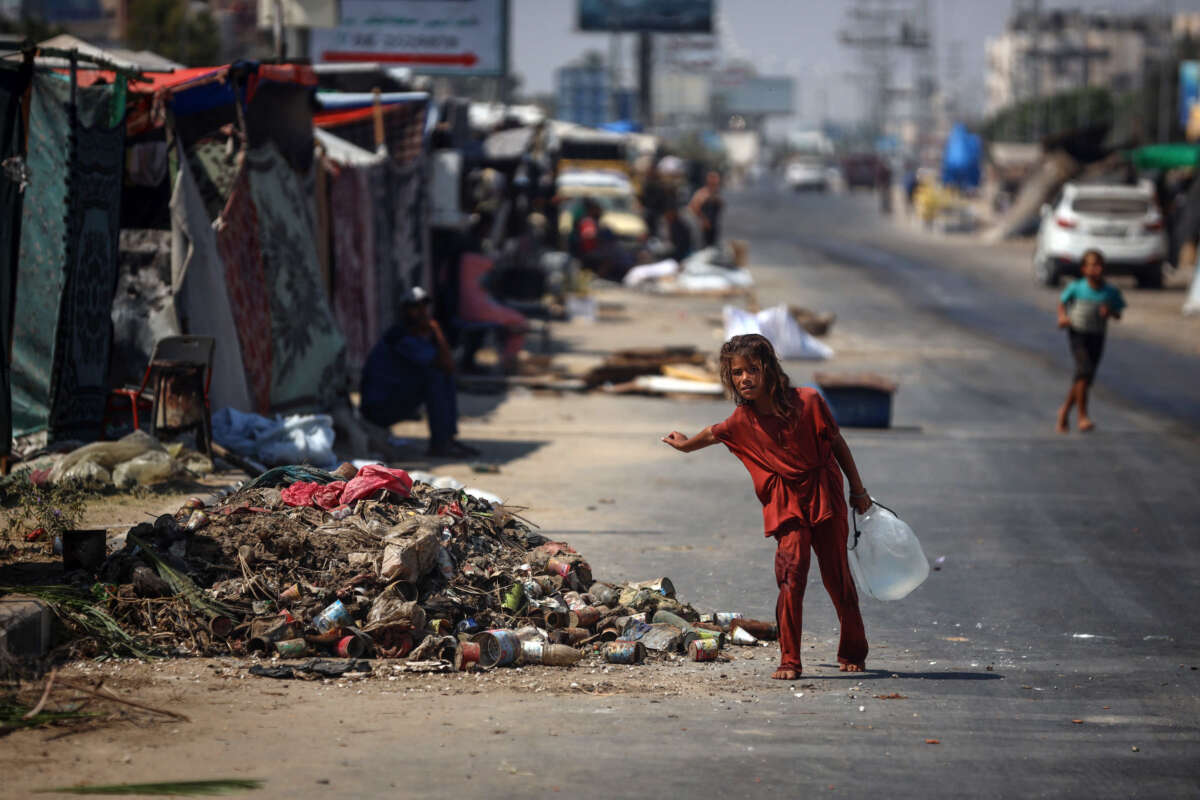Israel’s forced evacuations in Gaza are now so widespread that Palestinians are not only being almost completely separated from crucial resources like water, they are also being squeezed into a “safe zone” that has shrunk to a point where they are never more than a few blocks away from the frontline of Israel’s ground assault, humanitarian groups warn.
According to the UN Relief and Works Agency for Palestine Refugees (UNRWA) spokesperson Louise Wateridge, Israel’s so-called humanitarian safe zone, which Israel has also bombed many times, is essentially the frontline of what the Israeli military dubs the “combat zone.”
“Areas that were in the humanitarian zone are now the frontline,” Wateridge said, per the UN. Palestinians “are never more than a few blocks away from the frontline now.”
This week, Israel ordered yet more forced evacuations, this time from parts of Deir el-Balah. This is the 13th evacuation order this month.
These areas were previously part of the “safe zone,” meaning that the already tiny and overcrowded safe zone has shrunk even further; the “safe zone” now only encompasses 11 percent of Gaza. Palestinians are being pushed farther and farther toward the Mediterranean Sea — where they also face danger from Israeli naval forces.
Indeed, the “safe zone” is now so crowded that aid groups say it takes hours just to travel a short distance. Medical Aid for Palestinians (MAP) reported on Wednesday that it took one of its workers two hours to drive six kilometers, or 3.7 miles, from Deir el-Balah to Khan Yunis. In the background of that journey was the constant sound of gunfire, the worker said.
The UN Office for the Coordination of Humanitarian Affairs (OCHA) reported that the evacuations have now cut off parts of the main humanitarian route in Gaza, making it “nearly impossible” for workers to use this route. Convoys are forced to go through the road along the coast of Gaza, but that is “not a viable alternative” and is completely crowded with displaced Palestinians in makeshift shelters there.
The situation is severely hindering the movement of humanitarian aid across the region at a time when aid is needed more than ever.
In a joint statement published Thursday, a group of 27 aid groups said that Israeli forces’ evacuation orders this month have impacted at least 17 health facilities. The newly evacuated area of Deir el-Balah, meanwhile, is “one of the only remaining areas in the occupied Gaza Strip with essential infrastructure and warehouses storing aid supplies,” the group said.
Aid groups say that Israel’s latest expansion of the combat zone puts key infrastructure and resources out of reach for Palestinians. The UNRWA has reported that much of the “critical water wells and sanitation infrastructure” in Gaza are located in areas included in Israel’s evacuation orders. These are some of the few sanitation and water wells still operational across the Gaza Strip as Israel has systematically destroyed most of such infrastructure.
OCHA said that evacuations from Khan Yunis and Deir el-Balah in recent weeks have impacted areas one kilometer (about half a mile) or less from four key hospitals in the region: Nasser, al-Amal, Kuwaiti and al-Aqsa. Meanwhile, MAP has reported that they have a warehouse with 300 pallets of medical supplies that is now in the evacuation zone. Workers have only been able to safely retrieve about a third of those supplies, the group said.
We’re resisting Trump’s authoritarian pressure.
As the Trump administration moves a mile-a-minute to implement right-wing policies and sow confusion, reliable news is an absolute must.
Truthout is working diligently to combat the fear and chaos that pervades the political moment. We’re requesting your support at this moment because we need it – your monthly gift allows us to publish uncensored, nonprofit news that speaks with clarity and truth in a moment when confusion and misinformation are rampant. As well, we’re looking with hope at the material action community activists are taking. We’re uplifting mutual aid projects, the life-sustaining work of immigrant and labor organizers, and other shows of solidarity that resist the authoritarian pressure of the Trump administration.
As we work to dispel the atmosphere of political despair, we ask that you contribute to our journalism. Over 80 percent of Truthout’s funding comes from small individual donations from our community of readers, and over a third of our total budget is supported by recurring monthly donors.
You can help by giving today. Whether you can make a small monthly donation or a larger gift, Truthout only works with your support.
